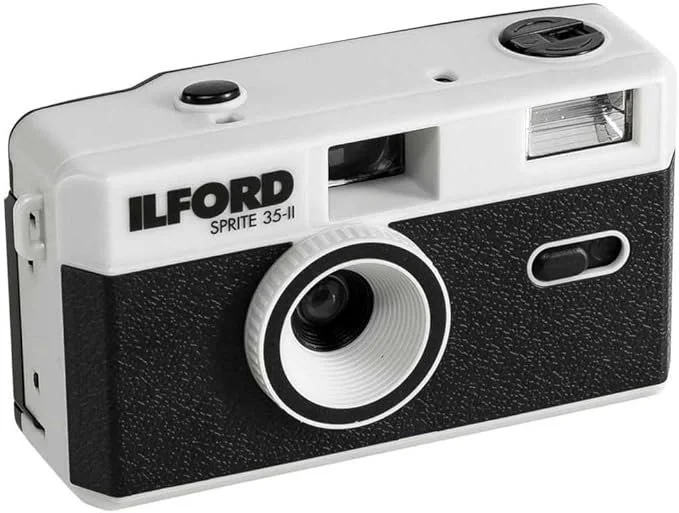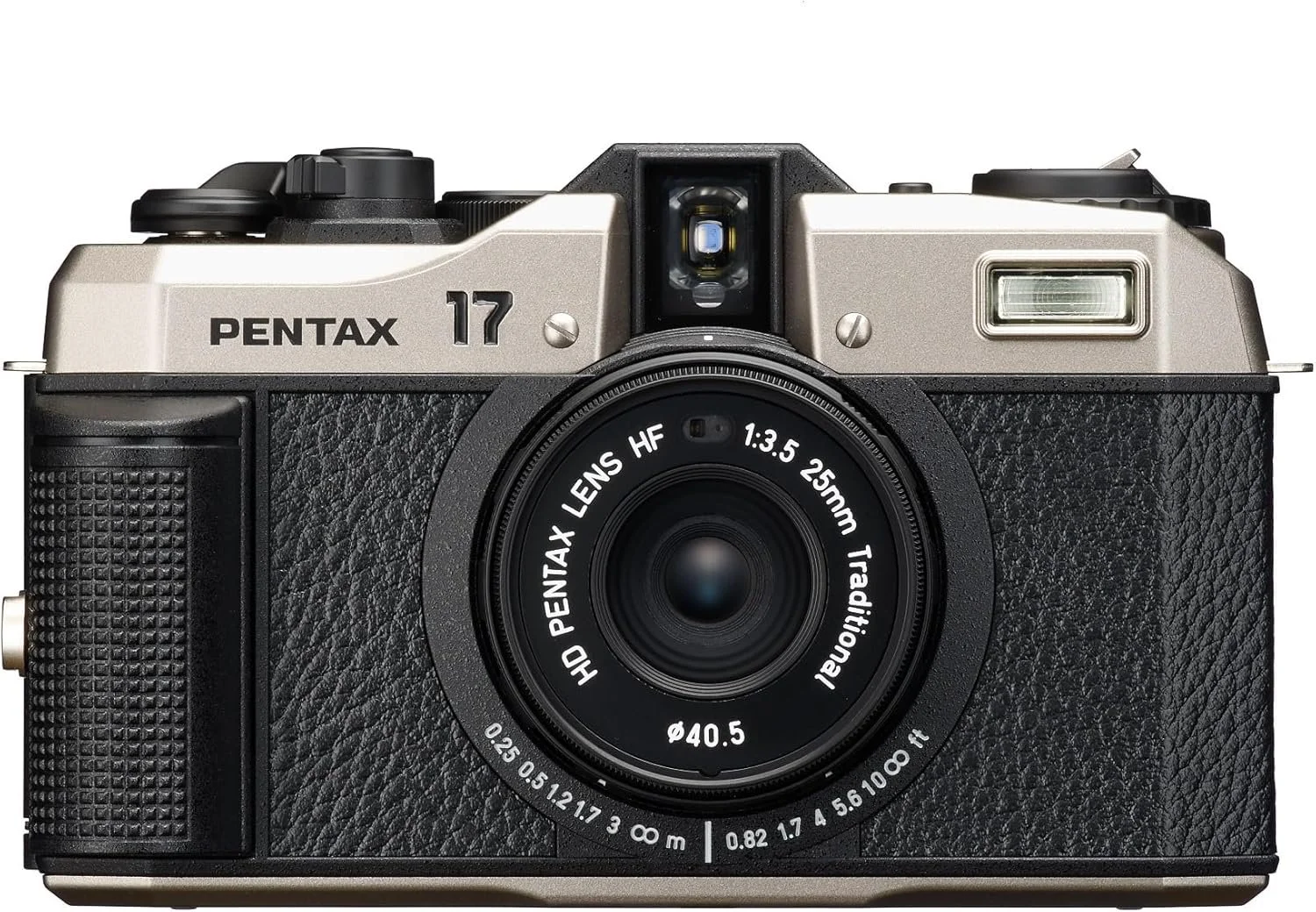Best Film Cameras for Beginners in 2025
How to Choose Your First Film Camera
Before you fall in love with a specific model, it helps to decide what kind of beginner you are. Ask yourself:
Do you want “point, shoot, and vibes”… or to learn photography?
If you want easy fun and memories, look at simple reusable / half-frame cameras and instant cameras.
If you want to understand shutter speed, aperture, and metering, look at a 35mm SLR with manual controls.
How much do you want to spend up front?
New reusable / half-frame cameras often run roughly $40–$150.
New “serious” film cameras like the Pentax 17 are more like entry-level digital camera money.
Used SLRs can still be had for sensible prices… but some classics are overpriced due to hype.
New vs used
New cameras: usually reliable, easy to return, but fewer models and mostly fixed-lens compacts.
Used cameras: more choice and better image quality for the price, but you’re gambling on 30–50-year-old electronics.
Format & running costs
35mm full-frame: the standard, easiest to find film & processing.
Half-frame 35mm: twice as many photos per roll, smaller negatives, slightly grainier prints.
120 / medium format: gorgeous quality but bigger, pricier, and not where most beginners should start.
Instant (Instax / Polaroid): film is more expensive per shot, but you get a print in your hand within a minute.
With that in mind, let’s walk through the best beginner options in 2025, broken down by how you’ll actually use them.
Category 1: Best “Just for Fun” 35mm Cameras (New, Cheap, Easy)
These cameras are perfect if you want to shoot film without thinking about f-stops, metering, or vintage repairs.
1. Kodak Ektar H35 / H35N – Best First Film Camera for Total Beginners
The Kodak Ektar H35 (and its newer sibling, the H35N) is one of the most widely recommended beginner cameras right now — and for good reason. Tech and photo guides highlight it as an ideal entry-level film camera: simple, affordable, and half-frame, so a 36-exposure roll gives you 72 photos.
Why it’s beginner-friendly
Half-frame format: You get double the shots from each roll, which matters a lot when film and lab costs are high.
Fixed everything: No worrying about shutter speed or aperture — the camera handles it for you.
Tiny & lightweight: Easy to toss in a bag, bring to concerts, parties, or vacations.
Flash built in: Helps a ton in indoor or evening situations where basic plastic lenses would otherwise struggle.
Downsides
Image quality is good enough for casual use, but nowhere near what you’d get from a solid SLR with a proper 50mm lens. Multiple reviewers point out that image quality is basic and low-light performance is limited without flash.
No real creative control: you can’t practice manual exposure or depth of field.
Who it’s for
People who say: “I just want cute film photos without learning all the technical stuff.”
Great for teens, casual shooters, and travel journaling.
2. Ilford Sprite 35-II / Long Weekend Reusable – Best Budget Reusable 35mm
Guides to affordable 35mm cameras usually group the Ilford Sprite 35-II, Long Weekend Reusable 35mm, and similar “simple reusable” cameras together. They’re basically upgraded disposable cameras you can reload.Moment
What they offer
Full-frame 35mm rather than half-frame, so each shot uses a normal-sized frame.
Single fixed lens, fixed shutter speed (typically around 1/120s) and fixed aperture (often f/8).
Manual wind and rewind that gives you the classic film feel.
Usually very lightweight plastic bodies, often for under $50–$70 new depending on brand and retailer.Moment
Pros
Simple, durable, and cheap.
Great way to get used to loading film and working within limitations.
Perfect for bright daylight, beach days, and street shooting in good light.
Cons
Weak in low light; you’ll rely on flash more often.
One fixed lens, no control over shallow depth of field.
Plastic optics mean softer images and occasional vignetting.
Who it’s for
Shooters who want film vibes, not technical mastery.
Parents or friends who want a low-stress camera to pass around at parties or holidays.
Category 2: Best Instant Film Camera for Beginners (Prints in Your Hand)
If you care more about having a physical print right now than about negative scans later, instant cameras are a blast — and incredibly beginner friendly.
3. Fujifilm Instax Mini 12 – Best Instant Camera for First-Timers
The Instax Mini 12 is widely recommended as the best beginner instant camera: digital camera and photo sites list it as the top budget instant pick, praising its simplicity, affordability, and surprisingly good image quality.
Fujifilm’s own spec sheet backs this up — it has automatic exposure, built-in flash control, and a very simple “twist to turn on, twist again for close-up mode” operation.
Why it’s great for beginners
Zero settings to worry about: The camera meters light and controls flash automatically. You just frame and press the button.
Close-up / selfie mode: Twist the lens and you get a closer focusing distance (around 30–50 cm), which is perfect for selfies and detail shots.
Cheap(er) instant film: Instax Mini film is one of the more affordable instant formats, with small credit-card-sized prints.
Fun colors and design: It’s deliberately cute and approachable, which helps people not be intimidated by “a camera.”
Downsides
You pay more per shot than with 35mm film, even though there’s no lab fee.
Tiny prints — great for journaling and sharing, but not the same look as 4x6 darkroom prints.
No exposure compensation: you get what the camera decides.
Who it’s for
People who want immediate physical keepsakes at parties, weddings, or family events.
Great first camera for kids and teens; easy to use & fun to share.
Category 3: Best Brand-New “Serious” Film Camera – Learn on Something Modern
If you want a camera that feels like “real gear” in 2025 but don’t want to roll the dice on a 40-year-old SLR, there is finally a real option again.
4. Pentax 17 – Best New Film Camera for Enthusiast Beginners
The Pentax 17 is a big deal: it’s the first brand-new 35mm film camera from a major manufacturer in almost 20 years. Ricoh (Pentax’s parent) designed it as a compact, retro-styled camera that still gives you a traditional film experience: manual film advance, mechanical dials, and a fixed lens.
Key specs & features
Half-frame 35mm: shoots 17×24 mm frames, so you get 48 frames from a 24-exposure roll and 72 from a 36-exposure roll.
23mm f/3.5 fixed lens (roughly a 37mm equivalent field of view).
Zone focusing: you select focus distances using icons (portrait, group, landscape, macro, etc.).
Program and manual-style exposure modes: the camera uses a built-in meter to set exposures, but settings are chosen with traditional dials rather than menus.
Recent reviews describe the Pentax 17 as lightweight, reliable, and fun, emphasizing that it feels like a modern take on a classic film compact rather than a gimmick.
Pros
Brand-new manufacture: as of late 2025 it’s in active production, with support and warranty options — rare in the film world.
Half-frame economy: again, double the photos per roll, really handy in 2025 film pricing.
Manual feel without vintage headaches: you still get to advance film and choose focus zones, but without sticky shutters or foam seals from the 1970s.
Cons
More expensive upfront than the plastic beginner cameras or most used SLRs.
Half-frame negatives are smaller, so big prints will show more grain than full-frame 35mm.
Fixed lens; if you dream of swapping lenses, this isn’t it.
Who it’s for
Someone who wants a new, serviceable, and stylish film camera with a tactile shooting experience and doesn’t mind paying extra.
Great for travel, street, and everyday photography where a compact camera is a plus.
Category 4: Best Used 35mm SLRs for Beginners (for Learning Photography)
If your goal is to truly learn exposure and manual control, nothing beats a 35mm SLR with a normal prime lens. The used market is full of options, and photo publications still highlight some classics as student/beginner favorites.Digital
A couple of important notes before specific recommendations:
Some “famous beginner cameras” like the Pentax K1000 and Canon AE-1 have become overpriced relative to comparable alternatives, and some have known reliability issues (like failing capacitors in certain models).
Late-era autofocus SLRs (mid-1990s to early 2000s) are often cheaper and more reliable than older all-mechanical icons, and they still shoot 35mm film just fine.
With that in mind, here are solid categories and examples, rather than “you must buy this one exact body.”
5. Pentax ME Super / Other Pentax M-Series – Classic Compact Manual SLR
Guides to film cameras often call the Pentax ME Super a great starter SLR: compact, relatively inexpensive, and offering a good balance between automatic and manual controls.
Why it works for beginners
Aperture priority + manual modes: you can start with auto exposure and then switch to manual when you’re ready.
Bright viewfinder and excellent Pentax-M 50mm lenses that are plentiful and reasonably priced.
Smaller and lighter than some chunkier SLRs, easier to carry all day.
Things to watch
These are still decades-old cameras. Light seals and electronics can fail, so it’s worth buying from a reputable seller or budgeting for a CLA (clean, lube, adjust).
The meter and shutter rely on batteries — not a big deal, but if the electronics die, you’re stuck.
Who it’s for
Beginners who definitely want to learn exposure and focusing, and who enjoy mechanical dials and levers.
People who like the idea of building a small Pentax lens kit over time.
6. Canon AE-1 Program / Minolta X-700 & Friends – The Popular Classics (with Caveats)
Articles on “best 35mm cameras” almost always mention Canon AE-1, AE-1 Program, Minolta X-700, and similar 1970–1980s SLRs as great teaching tools: full manual controls, plus shutter-priority or program modes.
They are excellent to shoot with:
Big, bright viewfinders.
Plenty of compatible 50mm f/1.4 or f/1.8 lenses that offer beautiful, sharp images.
Very tactile; they feel like “real cameras,” which can motivate new shooters.
However, more critical voices in the film community have pointed out that these specific bodies are often over-recommended and overpriced, and some have known reliability issues (for example, capacitor failures in some Canon and Minolta models).
Takeaway:
If you find a Canon AE-1 Program, Minolta X-700, Olympus OM-1, etc. in verified good working order at a sensible price, they can be fantastic first SLRs. Just don’t feel like you have to chase one of these names; lesser-known models from the same brands often give you 95% of the experience for half the cost.
7. Late-Era Autofocus SLRs – The Underrated Beginner Bargains
One of the best beginner hacks in 2025 is to look at late-1990s and early-2000s autofocus SLRs from Canon, Nikon, Minolta, and Pentax. Reviews of cameras like the Minolta Maxxum 5 point out that these “plastic fantastics” have sophisticated meters, multiple exposure modes, and are often dirt cheap on the used market.
Why they’re great for learning
Full manual control + auto modes: You can start on Program mode and gradually move to aperture priority and full manual.
Accurate metering: These cameras benefit from decades of refinement in exposure systems, making it easier to get usable negatives while you learn.
Cheap bodies, decent lenses: Because they’re not “cool retro,” bodies are very affordable, and basic zooms or 50mm primes are accessible.
Trade-offs
Mostly polycarbonate (plastic) construction — they don’t feel as “retro” as an all-metal SLR.
Heavier reliance on electronics; if they die, repair may not be worth it.
Design is more “early 2000s DSLR” than “vintage film charm,” which some beginners care about.
Who it’s for
Beginners who prioritize results and learning over the nostalgia factor.
Anyone who already owns compatible lenses (e.g., Canon EF or Nikon F-mount) from digital gear.
Category 5: Fun & Experimental Cameras (Holga & Toy Cameras)
Once the basics are covered, you might want to lean into the lo-fi, unpredictable side of film.
8. Holga 120N / Holga 135 – Best for Embracing Imperfection
Many “best beginner film camera” lists include cameras like the Holga 135BC or Holga 120N as great ways to explore film without perfectionism. They’re cheap, plastic, and famous for lens quirks, light leaks, and vignetting.
Pros
Encourage experimentation: multiple exposures, motion blur, and weird framing.
Extremely simple controls — often just a couple of aperture icons and a single shutter speed.
Teach you to stop worrying about technical perfection and chase interesting light and subjects instead.
Cons
Not ideal as your only camera if you need predictable results.
Image quality is intentionally soft and distorted.
For 120 models, medium-format film is pricier and processing is less common than 35mm.
Who it’s for
People who already have (or plan to get) a more conventional camera, but want a fun sidekick.
Creative shooters who love “happy accidents.”
Practical Buying Tips for 2025
Regardless of which category you lean toward, a few practical tips will make your first film camera experience much better:
Budget for film and processing, not just the camera
Even with half-frame cameras that stretch your roll, film prices and lab costs add up. Plan on at least a few rolls plus developing when you buy.If buying used, favor working condition over famous names
A lesser-known Pentax, Minolta, or Nikon that’s been recently serviced will outperform a famous model with a gummed-up shutter every time. Articles calling out “overhyped beginner cameras” exist for a reason.Get a normal lens (around 35–50mm)
For SLRs, a 50mm f/1.8 (or similar) is usually inexpensive and optically excellent. Guides to 35mm classics repeatedly highlight these lenses as ideal for learning composition and exposure.Check battery types and availability
Many older cameras use common button cells; some use discontinued mercury cells that require workarounds. Double-check before you buy.Start with one camera and one lens
It’s tempting to collect, but you’ll learn more by shooting multiple rolls through a single setup, seeing how it behaves in different light.
So… Which Camera Should You Buy?
Here’s a quick summary based on goals:
“I want easy film vibes and lots of photos per roll.”
→ Kodak Ektar H35/H35N or similar half-frame reusable.“I want prints in my hand right away for parties, weddings, and family stuff.”
→ Fujifilm Instax Mini 12 — simple, cheap to run (for instant), and highly recommended for beginners.“I want a new, reliable camera with a classic feel.”
→ Pentax 17 – the only truly modern 35mm camera from a major brand, with half-frame economy and a tactile shooting experience.“I want to really learn exposure and manual control.”
→ A used 35mm SLR with a 50mm lens: think Pentax ME Super or similar, or an underrated late-era autofocus SLR from Canon, Nikon, Minolta, or Pentax.“I already have a main camera and want something weird and creative.”
→ Holga or other toy cameras; they’re a great second camera for experimentation.
Whichever path you choose, the most important step is simple: shoot regularly. Load a few rolls, make mistakes, and learn what kind of images genuinely make you excited to pick up the camera again. In 2025, there’s no single “best” beginner film camera — but there is a best one for how you want to shoot.




